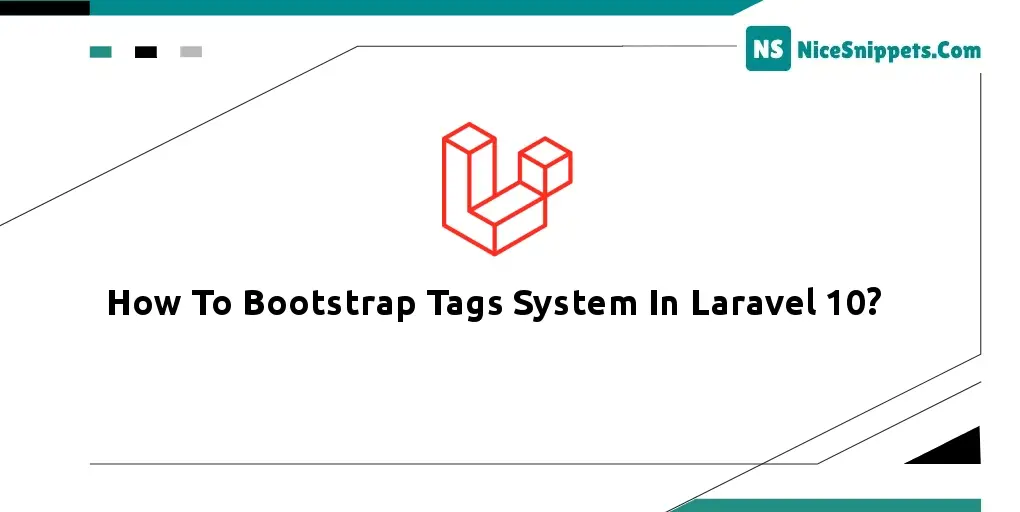02-May-2023
.
Admin

Hi Friends,
This example is how to bootstrap the tags system in laravel 10?.
This example is a shortcode and an easy way to understand users.
You will learn how to create a tag system in the Laravel 10 application using the laravel-tagging package.
So let's start following the steps.
Step 1: Download Laravel
Let us begin the tutorial by installing a new laravel application. if you have already created the project, then skip the following step.
composer create-project laravel/laravel example-app
Step 2: Database Configuration
The database is connected to the app by adding database details into the .env configuration files.
.env
DB_CONNECTION=mysql
DB_HOST=127.0.0.1
DB_PORT=3306
DB_DATABASE=database_name
DB_USERNAME=database_user_name
DB_PASSWORD=database_password
Step 3: Install Laravel Tagging Package
Next, open the terminal and add the command to install the laravel tagging package; this package offers tag support for Laravel Eloquent models recklessly.
composer require rtconner/laravel-tagging
Step 4: Add Tagging Service
config/app.php
....
....
'providers' => [
....
....
\Conner\Tagging\Providers\TaggingServiceProvider::class,
....
....
]
Step 5: Publish Tagging Service
below command to publish in laravel.
php artisan vendor:publish --provider="Conner\Tagging\Providers\TaggingServiceProvider"
Next, you have to run a command to run the migration for the tags system, and it will generate tagging tables in the database.
php artisan migrate
Step 6: Add Model and Migration
php artisan make:model TagPost -m
app/Models/Post.php
<?php
namespace App\Models;
use Illuminate\Database\Eloquent\Factories\HasFactory;
use Illuminate\Database\Eloquent\Model;
class TagPost extends Model
{
use HasFactory;
use \Conner\Tagging\Taggable;
/**
* The attributes that are mass assignable.
*
* @var array
*/
protected $fillable = [
'title_name',
'content'
];
}
Now, get into the database/migrations/create_posts_table.php, and you have to insert the table values into this migration file.
database/migrations/create_posts_table.php
<?php
use Illuminate\Database\Migrations\Migration;
use Illuminate\Database\Schema\Blueprint;
use Illuminate\Support\Facades\Schema;
return new class extends Migration
{
/**
* Run the migrations.
*
* @return void
*/
public function up()
{
Schema::create('tag_posts', function (Blueprint $table) {
$table->id();
$table->string('title_name');
$table->text('content');
$table->timestamps();
});
}
/**
* Reverse the migrations.
*
* @return void
*/
public function down()
{
Schema::dropIfExists('tag_posts');
}
}
Consequently, you have to execute a command to run migrations.
php artisan migrate
Step 7: Add Controller
Let’s generate a new controller with the help of the following command.
php artisan make:controller TagController
app/Http/Controllers/TagController
<?php
namespace App\Http\Controllers;
use Illuminate\Http\Request;
use App\Models\TagPost;
class TagController extends Controller
{
/**
* Write code on Method
*
* @return response()
*/
public function index()
{
$tags = TagPost::all();
return view('tag',compact('tags'));
}
/**
* Write code on Method
*
* @return response()
*/
public function store(Request $request)
{
$this->validate($request, [
'title_name' => 'required',
'content' => 'required',
'tags' => 'required',
]);
$input = $request->all();
$tags = explode(",", $request->tags);
$post = TagPost::create($input);
$post->tag($tags);
return back()->with('success','Tags added to database.');
}
}
Step 8: Add Route
routes/web.php
<?php
use Illuminate\Support\Facades\Route;
use App\Http\Controllers\TagController;
/*
|--------------------------------------------------------------------------
| Web Routes
|--------------------------------------------------------------------------
|
| Here is where you can register web routes for your application. These
| routes are loaded by the RouteServiceProvider within a group which
| contains the "web" middleware group. Now create something great!
|
*/
Route::get('/show-tags', [TagController::class, 'index']);
Route::post('/create-tags', [TagController::class, 'store']);
Step 9: Add Blade File
resources/views/tag.blade.php
<!DOCTYPE html>
<html lang="{{ str_replace('_', '-', app()->getLocale()) }}">
<head>
<meta charset="utf-8">
<meta name="viewport" content="width=device-width, initial-scale=1">
<title>Laravel 10 Tags System Example - Nicesnippets.com</title>
<link href="https://cdn.jsdelivr.net/npm/bootstrap@5.0.2/dist/css/bootstrap.min.css" rel="stylesheet">
<link href="https://cdnjs.cloudflare.com/ajax/libs/bootstrap-tagsinput/0.8.0/bootstrap-tagsinput.css" rel="stylesheet" />
<style>
.bootstrap-tagsinput .tag{
margin-right: 2px;
color: #ffffff;
background: #2196f3;
padding: 3px 7px;
border-radius: 3px;
}
.bootstrap-tagsinput {
width: 100%;
}
</style>
</head>
<body>
<div class="container mt-5">
<h3 class="text-center mb-5">Laravel 10 Tags System Example - Nicesnippets.com</h3>
<div class="row justify-content-center">
<div class="col-md-8">
@if(Session::has('success'))
<div class="alert alert-success">
{{ Session::get('success') }}
@php
Session::forget('success');
@endphp
</div>
@endif
<form action="{{ url('create-tags') }}" method="POST">
{{ csrf_field() }}
<div class="mb-3">
<input type="text" class="form-control" name="title_name" placeholder="Enter title">
@if ($errors->has('title_name'))
<span class="text-danger">{{ $errors->first('<title></title>') }}</span>
@endif
</div>
<div class="mb-3">
<textarea class="form-control" name="content" placeholder="Enter content"></textarea>
@if ($errors->has('content'))
<span class="text-danger">{{ $errors->first('content') }}</span>
@endif
</div>
<div class="mb-3">
<input class="form-control" type="text" data-role="tagsinput" name="tags">
@if ($errors->has('tags'))
<span class="text-danger">{{ $errors->first('tags') }}</span>
@endif
</div>
<div class="d-grid">
<button class="btn btn-info btn-submit text-white">Submit</button>
</div>
</form>
<div class="alert alert-success p-1 mt-3 text-center">
Tag Collection
</div>
@if($tags->count())
@foreach($tags as $key => $tag)
<h3><strong>Title</strong> : {{ $tag->title_name }}</h3>
<p><strong>Content :</strong> {{ $tag->content }}</p>
<div>
<strong>Tag:</strong>
@foreach($tag->tags as $tag)
<label class="badge bg-primary">{{ $tag->name }}</label>
@endforeach
</div>
@endforeach
@endif
</div>
</div>
</div>
<script src="https://ajax.googleapis.com/ajax/libs/jquery/3.5.1/jquery.min.js"></script>
<script src="https://cdnjs.cloudflare.com/ajax/libs/bootstrap-tagsinput/0.8.0/bootstrap-tagsinput.js"></script>
</body>
</html>
Run Laravel App:
All steps have been done, now you have to type the given command and hit enter to run the Laravel app:
php artisan serve
Now, you have to open the web browser, type the given URL and view the app output:
http://localhost:8000/show-tags
I hope it can help you...
#Laravel 10